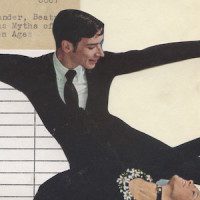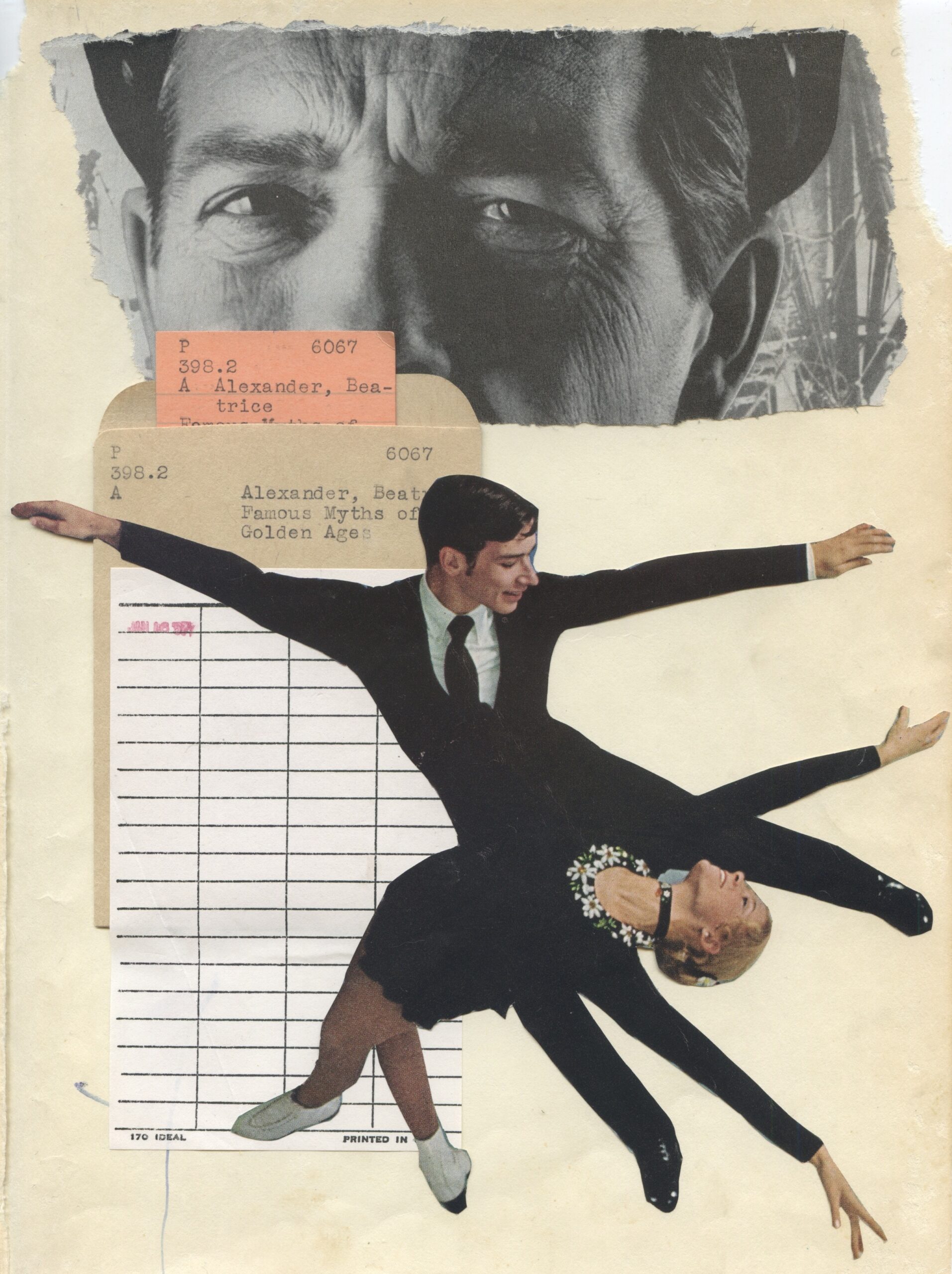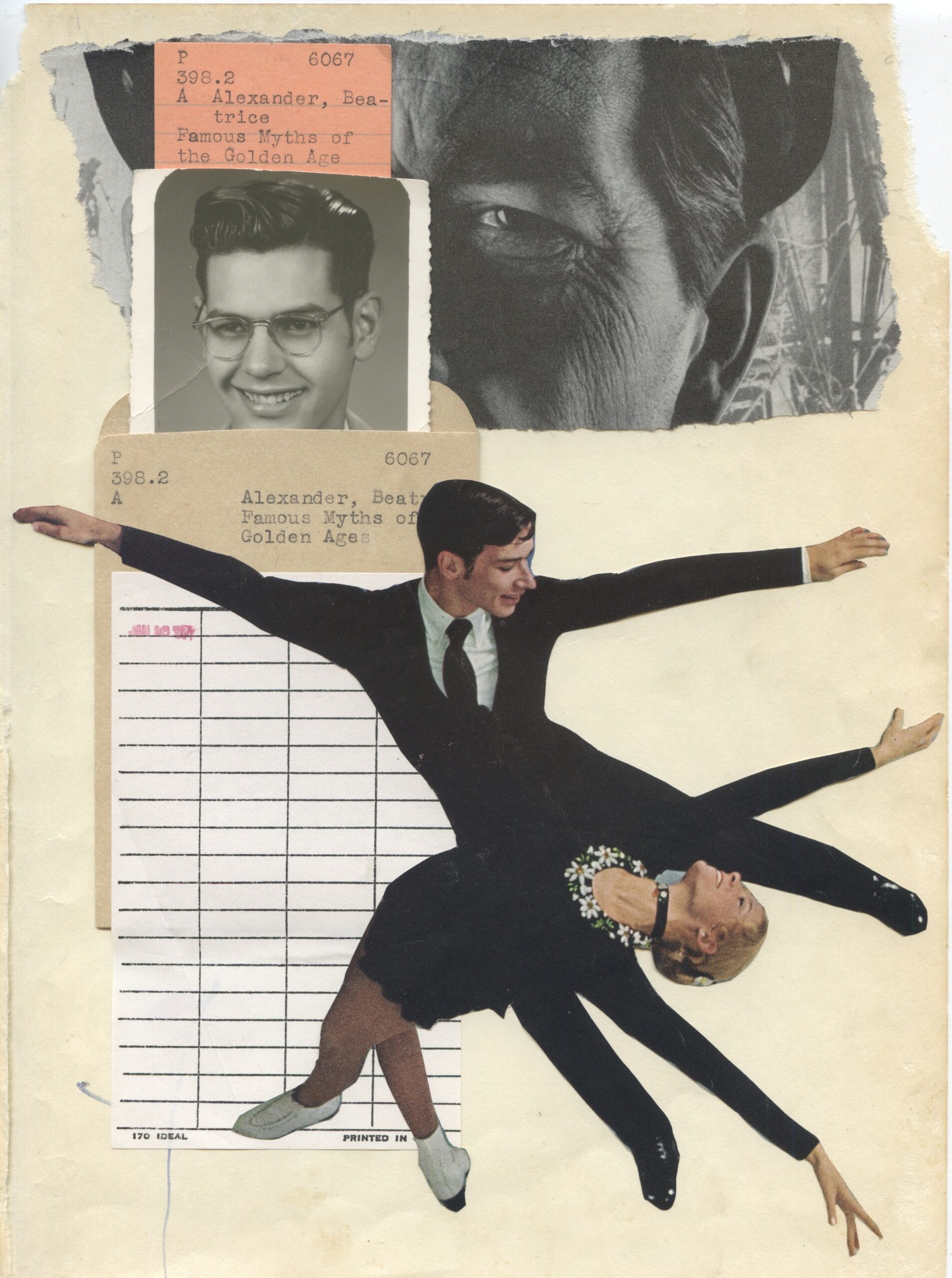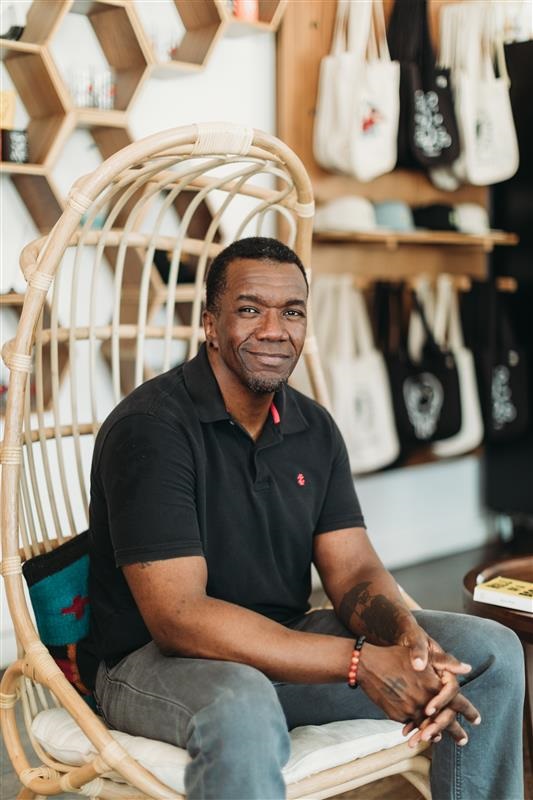Click image to enlarge:
***
Notes on these collages:
- I found the old library stamp card in a discarded library book called Famous Myths of the Golden Age. I remember these cards in school library books when I was a kid. I glued a found photo to the peach-colored pull-out card. The photo, found at a great store in Portland called SMUT (So Many Unique Treasures), shows a young gentleman with beautifully greased-back hair and a dapper shirt, tie, and zip-up jacket combo. It’s hard to tell what year the portrait was taken.
- I’d like to do more collages that have detachable parts, things you can move and goof around with.
- I just googled “Figure skating duo 1970s” and other variations of that for the past half-hour. I can’t remember where I got these figure skaters but I think it was from a 1976 Sports Illustrated about the Olympics. Right before I gave up my search, I came across Lyudmila Pakhomova and Alexander Gorshkov,who were the Olympic champions in 1976. This is part of the mystery and sometimes frustration of doing collage—trying to remember where things came from.
- The man’s piercing gaze at the top of the collage is from a cigarette ad. Philosophically, I’m uncertain how the things in these images work together, but visually, I’m very happy about all the things it seems to be offering (seriousness, nostalgia, beauty, and skill).
Paper Trumpets Spotlight: Quisqueya Henríquez
Emerging from the avant garde Cuban art scene of the 1980s, Quisqueya Henríquez has produced work in a staggering amount of mediums including performance art, photography, film, print, sound, video diaries, and collage. Her work is playful and outspoken and her collages, in particular, use familiar imagery that somehow lull you into a comfortable place in your mind until you realize that things are actually a little mixed up. I sent her some questions via email and was thrilled that she had time to answer them.
The Rumpus: When did you first start collaging and what attracted you to it?
Quisqueya Henríquez: In 2006 I started working on the series Baseball Players; that’s when I first incorporated collage into my artistic practice. I was interested in two aspects mainly: one, the nature of the images of the players as they appear in the printed newspapers—I mean the quality of newsprint, its fragility and its imminent demise in time and also the scale of the images. If I want to make a large collage, I have to cut hundreds of figures; that is why most of the pieces in the series are small.
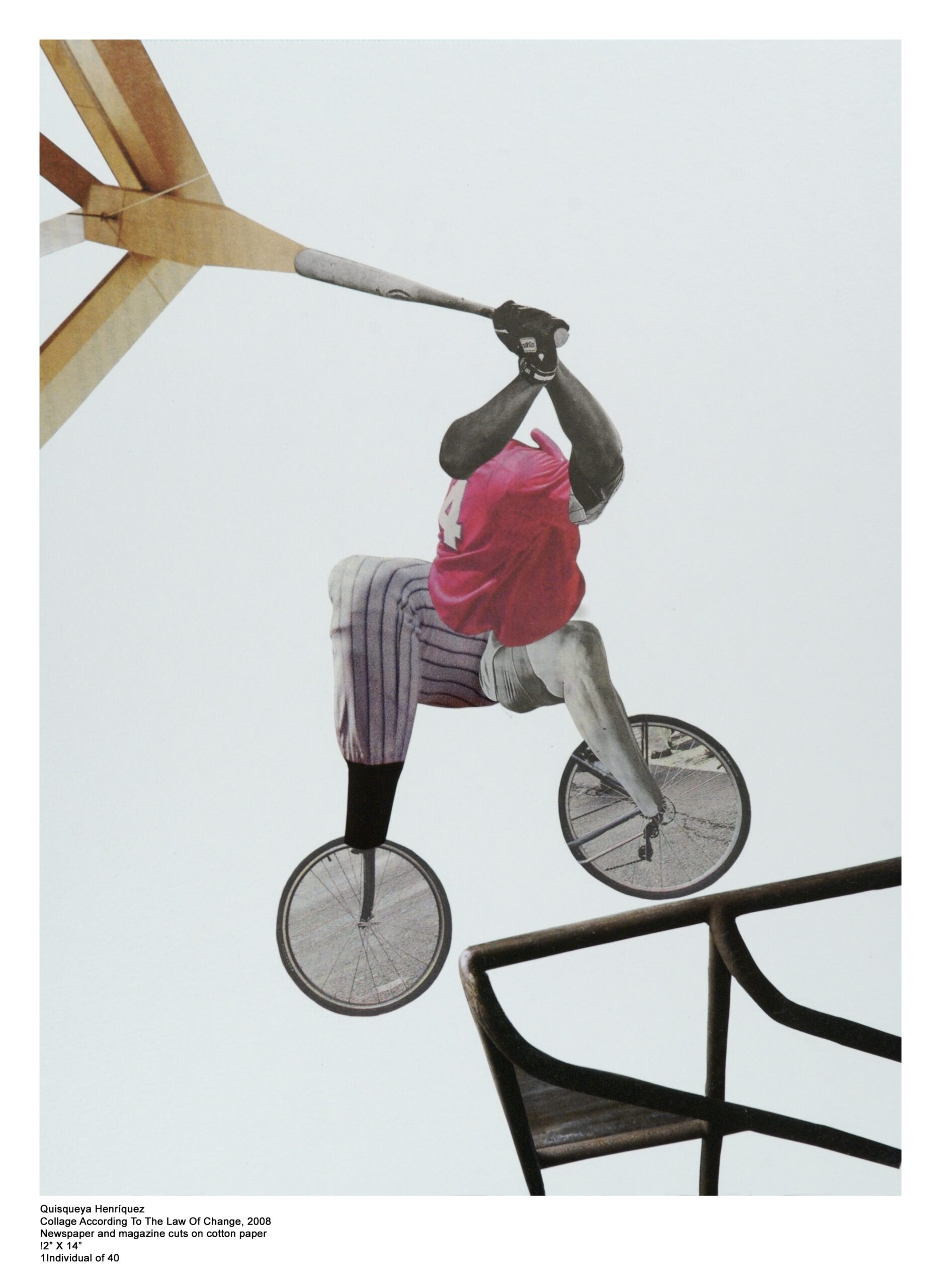 The second is a historical aspect that relates to what artist in the history of Western art used this technique for the first time. I read once that this place in art history is disputed between Hannah Höch and Raoul Hausmann. That story reflects, as in the case of Le Corbusier and Charlotte Perriand, that the true significance and importance of women, even today, remains in the shadow of a male figure, when many times, either personally or professionally, every aspect of human endeavor is the result of a joint effort. Both artists began making collages from an experience lived together, but in most of the texts it appears that he is the one who has an influence over her. That’s why in many of the figures of the Baseball Players series I add feminine elements. I enjoy feminizing male bodies.
The second is a historical aspect that relates to what artist in the history of Western art used this technique for the first time. I read once that this place in art history is disputed between Hannah Höch and Raoul Hausmann. That story reflects, as in the case of Le Corbusier and Charlotte Perriand, that the true significance and importance of women, even today, remains in the shadow of a male figure, when many times, either personally or professionally, every aspect of human endeavor is the result of a joint effort. Both artists began making collages from an experience lived together, but in most of the texts it appears that he is the one who has an influence over her. That’s why in many of the figures of the Baseball Players series I add feminine elements. I enjoy feminizing male bodies.
Many people ask me if a famous baseball player has ever seen the work I’ve done with the images of their bodies. But I always think they’re not going to like the transformation, being mutilated, feminized, or merged with the body of a woman who overshadows them.
Rumpus: I discovered your work in the book, Cut & Paste: 21st Century Collage. Those baseball collages are so good. Did this come about from a love of the sport or did you just find the images interesting. Do you have other thematic groups of collage like these, or have plans for others in the future?
Henríquez: I see my work on the players as a logical step in my interest in exploring cultural stereotypes related to the Dominican Republic and the Caribbean. Before working on the Baseball Players series, which in Spanish is called Fragmentos Criollos, I worked on a series called Burlas (Mockeries), where I developed a series of projects and works related to geography, customs, and some preconceived notions about the tropics and the Caribbean. Baseball has a dimension that transcends the sport—it produces social mobility, it’s an identity element, locally it’s a phenomenon that presents the possibility of a change in the lives of those who manage to enter the Major Leagues and internationally is a phenomenon that functions as locator on the map. The map is baseball as sport; the region is a factory. The series began in 2006 and in 2008 I did not want to continue. I thought it was enough. Last year I came back to it because I felt I had not finished. It was just a pause of several years.
I don’t see collage only as the use of paper that comes from newspapers, magazines, and books; I see it as any procedure that mixes various elements. For my next show I’m working on a performance that develops appropriating the work of two artists: Piero Manzoni and Felix Gonzalez-Torres. The way I conceived the merger of these two artists’ works, the Magic Base and the Gogo Dancer, for me is a way of making collage.
There is also the subject of access to images via the Internet, I have been developing a body of work that poses what happens to the images that are in the public domain, photo sharing platforms, blogs, and websites. For next year, I’m working on a project called Generation FFFFOUND, about the influence of certain Internet platforms that consciously or unconsciously have shaped and influenced the work of a generation of artists. It is a project based on images found on the Internet that result in images of works that already exist or are created by artists specifically for the project.
I recently finished a piece in which I superimpose fragments of images of male bodybuilders on the pages of a Lynda Benglis catalogue. This work addresses the problem of ownership through images of works of art, which is one of the lines of work that I have been developing for some time, incorporating a different narrative about the body from what I did with the Baseball Players series. Body building seen from the construction of the perfect body and within a social discourse that I find interesting, comparing it to this 70s very subversive, feminist Lynda Benglis catalogue, and how contemporary discourse on collective processes is increasingly “valid and feasible, even desirable” (Francisco Javier Cortázar).
Rumpus: Do you use the Rorschach paint technique in your collage work at all? I saw a video where you talked about that.
Henríquez: I like working on several bodies of work at the same time. I enjoy coming and going from one to the other, and often they intersect, that’s when I find working this way really interesting. I have sometimes been criticized for this, but I’m not very good at putting ideas aside and waiting. I want to see them materialized immediately.
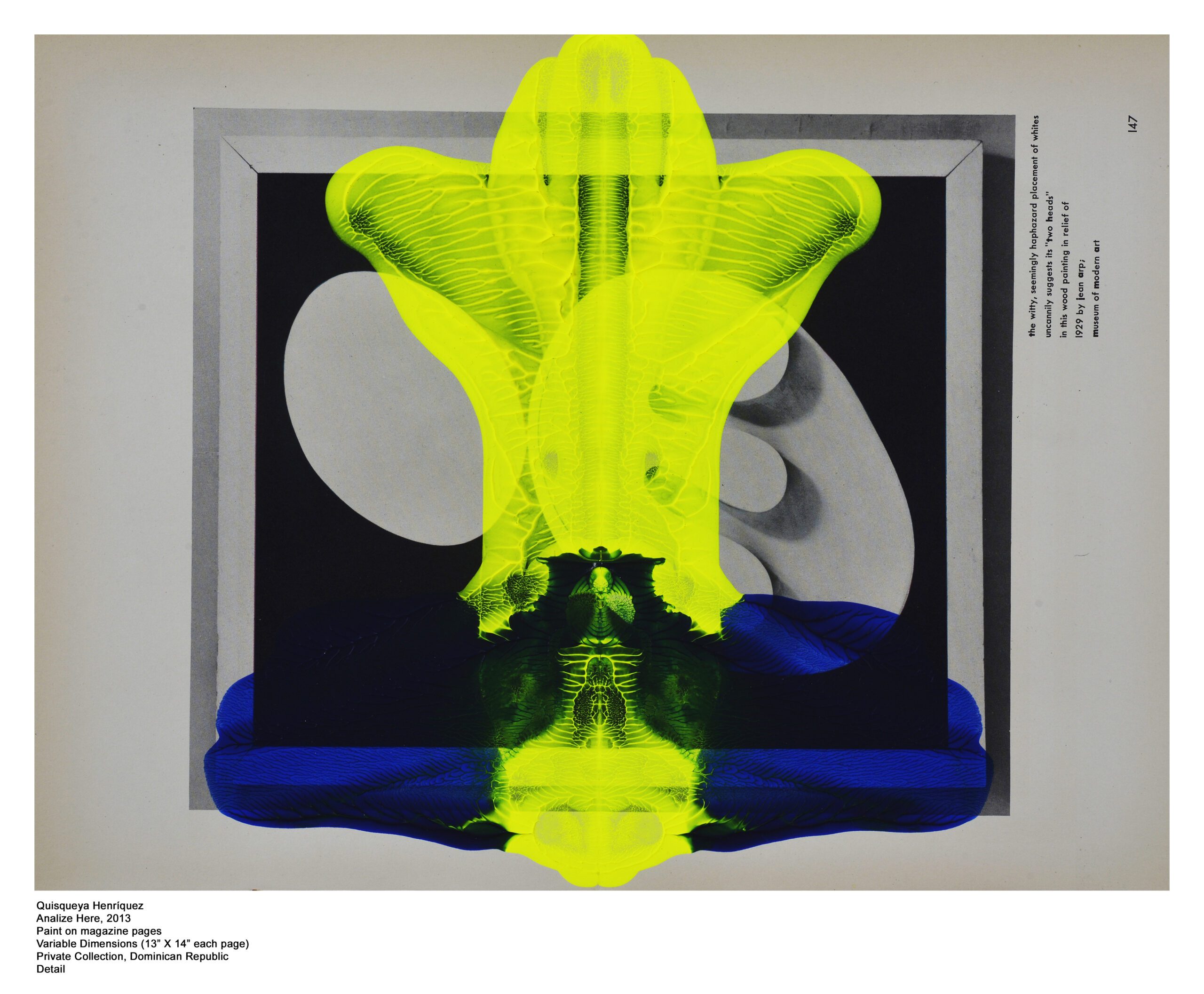 My works with Rorschachs stem from a personal story of Mies Van der Rohe, a personal story he used in his work, an element that I call emotional. I read once—I always read and forget the source—MVDR’s father was a stonemason and that’s why he decided to incorporate marble and stone in his architectural designs. I’m talking about the German Pavilion at the 1929 International Exposition in Barcelona; it’s in this building where the association between the emotional element linked to the work of his father and his rationalist designs is most evident. Stones in the hall walls are placed so that Rorschachs are formed with the natural drawings of the marble veining. I was always looking for pretexts to make a conceptual work that had its origin in this building and I was interested in exploring the not-so-obvious aspect of his work, the intimate and personal. Early on I made Rorschachs images called Volúmenes Ficticios (Fictitious Volumes), that are manipulated, printed images of architectural details with the paint discharge over them, often using more than one color and thick paint.
My works with Rorschachs stem from a personal story of Mies Van der Rohe, a personal story he used in his work, an element that I call emotional. I read once—I always read and forget the source—MVDR’s father was a stonemason and that’s why he decided to incorporate marble and stone in his architectural designs. I’m talking about the German Pavilion at the 1929 International Exposition in Barcelona; it’s in this building where the association between the emotional element linked to the work of his father and his rationalist designs is most evident. Stones in the hall walls are placed so that Rorschachs are formed with the natural drawings of the marble veining. I was always looking for pretexts to make a conceptual work that had its origin in this building and I was interested in exploring the not-so-obvious aspect of his work, the intimate and personal. Early on I made Rorschachs images called Volúmenes Ficticios (Fictitious Volumes), that are manipulated, printed images of architectural details with the paint discharge over them, often using more than one color and thick paint.
Then I continued using the famous test as a way to ignore the result, of having absolutely no control over what will come out, and even more interesting, though not the classic black inkblot created by Rorschach, people begin the process of what he called well-grounded abstraction, or a person’s ability to identify and read things on the spots.
Rumpus: You’ve had some shows in the US, including a big show at the Bronx Museum of the Arts, and you spend time in the States when you’re not at home in the Dominican Republic. How do those two cultures inform your work? And how do the two cultures react to your work?
Henríquez: I was born in Cuba and have not been back in over twenty years. I grew up in the Dominican Republic and then was absent for more than twelve years. And now, though I have my studio in Santo Domingo, I also work between NY and Miami. It is impossible to do it otherwise. It’s not just for reasons of visibility, positioning, and artistic projection—all that is true, but it is also an economic issue and there is no other way for this to happen, if not by traveling, doing artist residencies, and producing part of the work outside the Dominican Republic. The work is in this same dynamic; it’s here and there, part is produced locally and elsewhere internationally, with production standards that I can not get here. But what I find irreplaceable are the ideas that come from this place, that I generate here. For me it is essential to live and work here. I really like Maffesoli’s idea that “collective sensitivity is in a sense the phreatic mantle of all social life.” The energy that comes from that is very important in my creative process.
Rumpus: Do you feel like your collages are meant to express something personal for you or are you hoping to make a cultural statement?
Henríquez: I think one thing leads to another, or are rather inseparable. The personal in an artist is likely to become a cultural statement, the creation process itself does it naturally. Definitely the Baseball Players series is a cultural statement, it reflects the intricacies of the representation of the body in contemporary times; the body is transformed into something or someone you are not or do not want to be, contrary to plastic surgery, to the post-human body as conceived by Jeffrey Deitch in his famous nineties exhibition. For me Fragmentos Criollos retains the power to create what others do not expect, there is no negotiation between the body and what it’s expected of it aesthetically, no recognizable names or identities, the subject is a bunch of legs, arms, bats, and helmets, that end up glued on a paper or going around in my studio until I find them a place.
